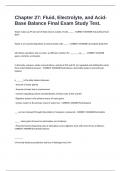Chapter 27: Fluid, Electrolyte, and Acid-
Base Balance Final Exam Study Test.
Water makes up 99 percent of fluid volume outside of cells, ____ - CORRECT ANSWER Extracellular fluid
(ECF)
Water is an essential ingredient of cytosol inside cells, ____ - CORRECT ANSWER Intracellular fluid (ICF)
All cellular operations rely on water, as diffusion medium for ____,____&____ - CORRECT ANSWER
gases, nutrients, and wastes
In the body, volumes, solute concentrations, and pH of ECF and ICF are regulated and stabilized by what
three interrelated processes? - CORRECT ANSWER Fluid balance, electrolyte balance and acid-base
balance
o ______ is the daily balance between
- Amount of water gained
- Amount of water lost to environment
· Involves regulating content and distribution of body water in ECF and ICF
· Digestive system is the primary source of water gains
· Urinary system is the primary route of water loss - CORRECT ANSWER Fluid balance
___ are ions released through dissociation of inorganic compounds - CORRECT ANSWER Electrolytes
____ - when gains & losses for electrolytes are in balance
· Primarily involves balancing rates of absorption across digestive tract with rates of loss at kidneys -
CORRECT ANSWER Electrolyte balance
_______,
o Precisely balances production and loss of hydrogen ions (H+)
,o Body generates acids during normal metabolism a reduces pH
o Kidneys
· Secrete H+ into urine
· Generate buffers that enter bloodstream
o Lungs affect pH through elimination of carbon dioxide - CORRECT ANSWER Acid-base balance
Solid (non-fluid) components of the body:
o 40% of male / 50% in females
· ____ 22%, ___ 14%, ___ 5%, ___ 4%, Miscellaneous <1% - CORRECT ANSWER Proteins, Lipids, Minerals,
Carbohydrates
____ has more water content than ECF - CORRECT ANSWER ICF
Water accounts for roughly
· ___ percent of adult male body weight (b/c more muscle)
· ___ percent of adult female body weight (b/c more adipose) - CORRECT ANSWER 60, 50
____ - the cytosol inside cells - CORRECT ANSWER Intracellular fluid (ICF)
_____,
· Major components:
- Interstitial fluid of peripheral tissues
- Plasma of circulating blood
· Minor components
- Lymph, cerebrospinal fluid (CSF), synovial fluid, serous fluids (pleural, pericardial, and peritoneal),
aqueous humor, perilymph, endolymph - CORRECT ANSWER Extracellular fluid (ECF)
o ECF and ICF are called fluid compartments because they "behave" differently and maintain different
ionic compositions
· _____
, - Sodium, chloride, and bicarbonate ions
· ____
- Potassium, magnesium, and phosphate ions
- Negatively charged proteins - CORRECT ANSWER ECF, ICF
o Osmotic concentrations of ICF and ECF are identical because plasma membranes are freely permeable
to _____
· Osmosis eliminates minor osmotic differences - CORRECT ANSWER water
Solute exchanges between the ECF and the ICF
o The plasma membrane is ____ freely permeable to most solutes
o Ion exchange between ICF and ECF occurs across ________ plasma membranes by
· Osmosis
· Diffusion
· Carrier-mediated transport (active and passive)
o Within the ECF, solutes may move from
· Across endothelial lining of capillaries
· Interstitial spaces a lymph a plasma - CORRECT ANSWER not, selectively permeable
All homeostatic mechanisms that monitor and adjust body fluid composition respond to changes in
____, not ___
· This is because the body doesn't have the ability to monitor and regulate the interior of trillions of cells
- CORRECT ANSWER ECF, ICF
No receptors directly monitor fluid or electrolyte balance
· Only blood volume and osmotic concentrations are monitored
- ____ monitor blood volume indirectly through blood pressure
- ____ in the hypothalamus monitor the concentration of solutes in the blood - CORRECT ANSWER
Baroreceptors, Osmoreceptors




